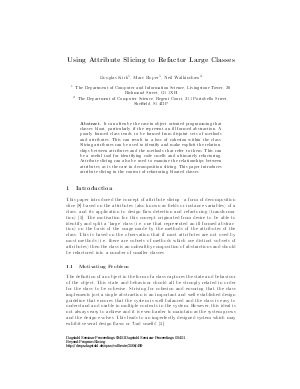Using Attribute Slicing to Refactor Large Classes
Authors Douglas Kirk, Marc Roper, Neil Walkinshaw
-
Part of:
Volume:
Dagstuhl Seminar Proceedings, Volume 5451
Part of: Series: Dagstuhl Seminar Proceedings (DagSemProc) - License:
 Creative Commons Attribution 4.0 International license
Creative Commons Attribution 4.0 International license
- Publication Date: 2006-07-07
File

PDF
DagSemProc.05451.10.pdf
- Filesize: 293 kB
- 12 pages
Document Identifiers
Subject Classification
Keywords
- Refactoring
- cohesion
- object-oriented slicing
Metrics
- Access Statistics
-
Total Accesses (updated on a weekly basis)
0Document
0Metadata
Abstract
It can often be the case in object-oriented programming that classes bloat, particularly if the represent an ill-formed abstraction. A poorly formed class tends to be formed from disjoint sets of methods and attributes. This can result in a loss of cohesion within the class. Slicing attributes can be used to identify and make explicit the relationships between attributes and the methods that refer to them. This can be a useful tool for identifying code smells and ultimately refactoring. Attribute slicing can also be used to examine the relationships between attributes, as is the case in decomposition slicing. This paper introduces attribute slicing in the context of refactoring bloated classes.
Cite As Get BibTex
Douglas Kirk, Marc Roper, and Neil Walkinshaw. Using Attribute Slicing to Refactor Large Classes. In Beyond Program Slicing. Dagstuhl Seminar Proceedings, Volume 5451, pp. 1-12, Schloss Dagstuhl – Leibniz-Zentrum für Informatik (2006)
https://doi.org/10.4230/DagSemProc.05451.10
BibTex
@InProceedings{kirk_et_al:DagSemProc.05451.10,
author = {Kirk, Douglas and Roper, Marc and Walkinshaw, Neil},
title = {{Using Attribute Slicing to Refactor Large Classes}},
booktitle = {Beyond Program Slicing},
pages = {1--12},
series = {Dagstuhl Seminar Proceedings (DagSemProc)},
ISSN = {1862-4405},
year = {2006},
volume = {5451},
editor = {David W. Binkley and Mark Harman and Jens Krinke},
publisher = {Schloss Dagstuhl -- Leibniz-Zentrum f{\"u}r Informatik},
address = {Dagstuhl, Germany},
URL = {https://drops.dagstuhl.de/entities/document/10.4230/DagSemProc.05451.10},
URN = {urn:nbn:de:0030-drops-4907},
doi = {10.4230/DagSemProc.05451.10},
annote = {Keywords: Refactoring, cohesion, object-oriented slicing}
}
